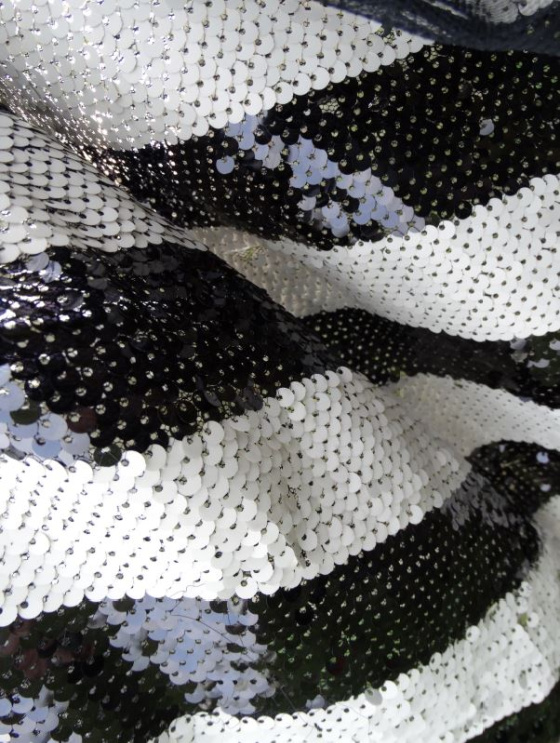Fashion Buying experts at De Montfort University Leicester (DMU) have named 10 practices that they predict will be extinct by 2090 to reduce the industry’s environmental impact.

Academics and students have collaborated closely on T-Extinction, a project reflecting DMU’s commitment to the United Nations’ Sustainable Development Goals.
Their findings are displayed in a thought-provoking exhibition in the ‘shopfront’ gallery – located at the base of the Vijay Patel Building’s Arts Tower until Thursday 27 May.
Sally Gaukrodger-Cowan, DMU senior lecturer and T-Extinction lead, said: “We came up with 2090 to reflect our students’ career journey. Many of them will have had the chance to make their mark on the industry by then and we hope this project sets them up for thinking sustainably and ethically.
“Our long-term ambition for the project is that it can be handed over to students and academics from other disciplines, who may respond or even start thinking about possible solutions.”

The 10 practices identified by academics and students in T-Extinction to be taboo in 90 years, are:
1. Incineration and landfills
Predicted by student Victoria Self: “With the fashion industry being one of the world’s biggest polluters, we need circular fashion to help reduce waste and the amount of product incinerated and ending up in landfill sites. Things are already becoming better now that more fabrics are being made using just one material type, making them easier to break down and reuse.”
2 Extreme distressed denim
Predicted by student Grace Pugh: “Extreme distressed denim is supplied in high volumes by fast fashion brands, but recent research suggests that it has poor colour fastnesses, resulting in its disposal by many after just a few wears. High volumes are turned towards landfills, polluting the atmosphere with CO2 and contributing to global warming.”

3. Fast fashion
Predicted by student Cailin Summers Pinchen: “Mass producing clothing cheaply, with cheap materials, can damage our eco system and water supplies, as well as be harmful and unsafe for the workers making the clothing.”
4. Sequins
Predicted by student Chelsea Rebecca Hayfield: “Attitudes towards single-use plastics are changing and I believe that the use of sequins in clothing will become extinct or replaced with a more eco-friendly alternative. In fact, since starting T-Extinction in 2020 more eco-friendly sequins are already reaching the market.”
5. Rubber soles
Predicted by senior lecturer Sally Gaukrodger-Cowan: “Consumer conscience and the need for circularity in the supply chain will drive sustainability and mean that traditional rubber soles and mixed component rubber soles should be consigned to history. Soles in 2090 will have a compostability and biodegradability, or a reclaimed quality, which will enable them to be manufactured from new sustainable sources or 100 percent recycled alternatives.”

6. Size ranges
Predicted by Head of School of Fashion and Textiles Professor Carolyn Hardaker: “Body size data sequences, which will hold a person’s 3D body scan data, will replace the traditional sizing systems. This data will provide an accurate representation of the body and will be used in the manufacture of clothing to obtain the perfect fit.
“While 3D scanning technology is readily available in the early 21st century, these scans are fixed in time and do not adapt to age or changes in body weight. The advent of deep learning could fine tune the models during a person’s lifetime by predicting that these individual body size data sequences will change as the individual ages.
“So no more non-standardised sizing, no more size names to navigate, but instead a body size data sequence for personalised bespoke garments that will fit perfectly for a lifetime.”
7. Nylon tights
Predicted by senior lecturer Dr Emily Baines: “Hosiery is one of the least sustainable items of clothing we own. Using vast quantities of nylon, polyester, acrylic and elastane from non-renewable oil stocks, they often have very short lifetimes, are rarely recycled, have highly toxic impacts on health and the environment, and pollute the oceans from microfibres at each wash. I believe that they will become extinct and that there will be evolution of materials to produce alternatives.”

9. Fibres
Predicted by student Tilda Eriksson: “Sustainability must start earlier in the supplier chain, with the fibres. I believe that in 2090 the fibre industry will no longer look the same. Instead of incinerating unwanted fabrics, technology will exist that can tear the fabric apart at least once. This could be the start of circular fashion.
“Gaining different perspectives has been the best part of this project. This is a subject we all need to be talking about, but it can feel so dramatic and overwhelming, so it’s been joyful to look at practical ways of moving in the right direction.”
10. Fashion trends
Predicted by student Mohamed Zougari: “Fashion buyers have a say in what people wear and in helping trends transition in and out of fashion, all of which is based on human decision and lacks the fundamentals of sustainability. As technology continues to advance and integrate with the fashion world, I see the role of the buyer becoming extinct and being replaced with AI that can predict trends while optimising sustainability.”
Posted on Tuesday 11 May 2021